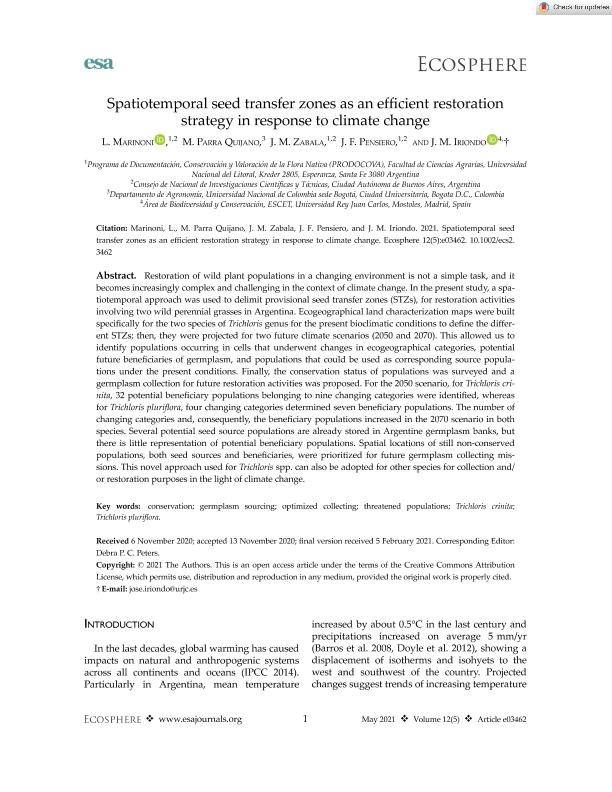Artículo
Spatiotemporal seed transfer zones as an efficient restoration strategy in response to climate change
Marinoni, Lorena del Rosario ; Parra Quijano, Héctor Mauricio; Zabala, Juan Marcelo
; Parra Quijano, Héctor Mauricio; Zabala, Juan Marcelo ; Pensiero, Jose Francisco
; Pensiero, Jose Francisco ; Iriondo Alegría, José María
; Iriondo Alegría, José María
 ; Parra Quijano, Héctor Mauricio; Zabala, Juan Marcelo
; Parra Quijano, Héctor Mauricio; Zabala, Juan Marcelo ; Pensiero, Jose Francisco
; Pensiero, Jose Francisco ; Iriondo Alegría, José María
; Iriondo Alegría, José María
Fecha de publicación:
05/2021
Editorial:
John Wiley & Sons Inc.
Revista:
Ecosphere
ISSN:
2150-8925
e-ISSN:
2150-8925
Idioma:
Inglés
Tipo de recurso:
Artículo publicado
Clasificación temática:
Resumen
Restoration of wild plant populations in a changing environment is not a simple task, and it becomes increasingly complex and challenging in the context of climate change. In the present study, a spatiotemporal approach was used to delimit provisional seed transfer zones (STZs), for restoration activities involving two wild perennial grasses in Argentina. Ecogeographical land characterization maps were built specifically for the two species of Trichloris genus for the present bioclimatic conditions to define the different STZs; then, they were projected for two future climate scenarios (2050 and 2070). This allowed us to identify populations occurring in cells that underwent changes in ecogeographical categories, potential future beneficiaries of germplasm, and populations that could be used as corresponding source populations under the present conditions. Finally, the conservation status of populations was surveyed and a germplasm collection for future restoration activities was proposed. For the 2050 scenario, for Trichloris crinita, 32 potential beneficiary populations belonging to nine changing categories were identified, whereas for Trichloris pluriflora, four changing categories determined seven beneficiary populations. The number of changing categories and, consequently, the beneficiary populations increased in the 2070 scenario in both species. Several potential seed source populations are already stored in Argentine germplasm banks, but there is little representation of potential beneficiary populations. Spatial locations of still non-conserved populations, both seed sources and beneficiaries, were prioritized for future germplasm collecting missions. This novel approach used for Trichloris spp. can also be adopted for other species for collection and/or restoration purposes in the light of climate change.
Archivos asociados
Licencia
Identificadores
Colecciones
Articulos (ICIAGRO-Litoral)
Articulos de INSTITUTO DE CIENCIAS AGROPECUARIAS DEL LITORAL
Articulos de INSTITUTO DE CIENCIAS AGROPECUARIAS DEL LITORAL
Citación
Marinoni, Lorena del Rosario; Parra Quijano, Héctor Mauricio; Zabala, Juan Marcelo; Pensiero, Jose Francisco; Iriondo Alegría, José María; Spatiotemporal seed transfer zones as an efficient restoration strategy in response to climate change; John Wiley & Sons Inc.; Ecosphere; 12; 5; 5-2021; 1-19
Compartir
Altmétricas



